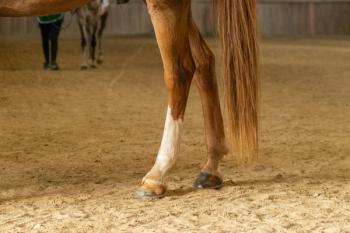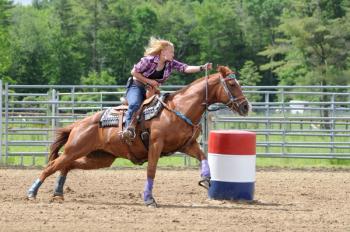
Update on fluid therapy in horses (Proceedings)
In general, sufficient fluids have been given when the horse/foal begins to pass urine.
Fluid Plans
•Replacement: Determining Rate
• New : 'Fluid Challenge' Method:
• Volumes are based on "fluid challenges" rather 'estimates' of deficits
• Traditional method is with estimates of % of water loss
o Riddled with errors....
"Fluid Challenge Method"
• 20 mL/kg boluses of isotonic crystalloid over 30-60 minutes, then reassess for more
o Repeat boluses until signs of shock abate or plateau, or until limits reached, indicating the need for vasopressors
o 10 L for an average adult horse
o 1 L for average neonatal foal
Fluid Challenge for Colloids
• Lower rates because they stay within the vascular space
o 3-10 mL/kg hetastarch
How much to give?
Base it on Clinical response
• Mentation
o Increase alertness
o Foal that is kicking is rarely severely hypovolemic
• Urination
o In general, sufficient fluids have been given when the horse/foal begins to pass urine
• Decrease heart rate
• Improvement in membrane color or capillary refill
• In hospital= blood pressure (> 60 mmHg in foal, 80 in adult)
Crystalloids vs. Colloids?
• Crystalloids only contain electrolytes or glucose in water
• Colloids contain large MW particles
o Proteins or synthetic polysaccharides
• Human studies fail to show an advantage of 1 over the other
o Use together may be ideal
• Isotonic crystalloids hydrate entire ECF
o 25 % to plasma volume; 75 % to interstitium
• Colloids expand the intravascular space only
• Rapid expansion of plasma volume
• Large particles stay within vessels
• Colloids are better in horses concurrently hypovolemic and hypooncotic
Replacement Crystalloids
• Choices:
o Lactated Ringer's Solution (LRS)
o Normosol-R
o Plasma-Lyte 148 or A
o Normal saline (0.9%)
Isotonic Crystalloids
LRS
• Contains calcium
o Not ideal when using blood products, sodium bicarbonate
• Contains lactate
• Contains potassium (4 mEq/L)
• Chloride is relatively high (109 mEq/L) relative to sodium (130)
o Na-Cl difference is 21 (ref: 40) – making this acidifying
• Clinical Uses:
o Botulism
o Endurance horses
• Do not use in:
o Oleander cases
o Not ideal in liver failure cases
Isotonic Crystalloids
Normosol R / PlasmaLyte 148 / PlasmaLyte A
• Contain magnesium (3 mEq/L)– no calcium
• Contain acetate/gluconate – no lactate
• Contain potassium (5 mEq/L)
• Sodium-chloride difference is optimal
o Na=140
o Cl=98
• Can use with HCO3 or PO4 or blood products
• Clinical Uses:
o Oleander and arrhythmia cases
o Brain injury cases
o Liver failure cases
• Do not use:
o Botulism cases
Isotonic Crystalloids
Physiologic saline (0.9 %)
• Contains only sodium and chloride
• Compatible with blood products, sodium bicarbonate
• No potassium
• Increases chloride concentration relative to sodium concentrations in equine plasma
o Mildly acidifying due to relative increase in chloride
Equine Plasma Saline
Na = 130-140 mEq/L 154 mEq/L
Cl = 90-100 mEq/L 154 mEq/L
Normal Saline
Clinical Uses:
• Do not use in acidemic cases
• Not optimal fluid for most cases, although can be used
• Good where potassium is not desirable
o HYPP
o Ruptured bladder
• Good for hypochloremic cases with alkalosis
o Some rhabdomyolysis cases
o Endurance horses not heavily supplemented
Colloids
Solutions containing large molecular weight (> 5000 Da) proteins or polysaccharides
Colloid Choices
• Natural colloids
o Plasma
o Whole blood
• Synthetic colloids
o Hetastarch
o Dextrans
Indications for Colloids
Hypovolemia with concurrent hypoproteinemia
• Examples:
o Colitis
o Lawsonia foals
• Crystalloids distribute among the entire ECF potentiating edema
• Colloids are restricted to the intravascular space, (assuming endothelial integrity)
o Less likely to cause edema
Hetastarch
• Large molecular weight synthetic pss in solution
• May have advantages over plasma during endotoxemia or sepsis with endothelial compromise
o Fraction with MW > 100,000 may be retained within vessels
o Smaller fractions and albumin may extravasate
• More cost effective than plasma on a per unit oncotic pressure basis
Hetastarch - Adverse Effects
Dose-dependent hemostatic alterations
• Induces a von Willebrand like state
o Prolongation of PT and PTT
• Coats platelet surface
o Alters platelet function
• May not want to use in pre-surgical case
• Don't use in bleeding cases
Hetastarch Doses
Suggested doses
• 10 mL/kg/day
o Safe, but do not exceed
Plasma
• Great colloid for foals
• Has antibodies for FPT, R. equi, other diseases
• Has clotting factors, antithrombin
• 40 ml/kg for foals whenever possible for FPT
o (2 L for average sized foal)
• Adult horses 2-3 L
Hypertonic Saline (7 %)
• Sodium: 1200 mEq/L
• Chloride: 1200 mEq/L
• Dose: Small volumes = 4 mL/kg
• Rapid, transient plasma volume expansion
o Borrows' water temporarily – increases blood volume and CO transiently
o Shifts water from interstitium and ICF until osmolarity equilibrates
Advantages
• Other potential advantages:
o Improvement in cardiac contractility (CO)
o Antiinflammatory
o Reduces endothelial and RBC edema Reduces neutrophil activation and endothelial adhesion
o Neurologic – reduces glutamate release, decreases intracellular calcium accumulation
Potential Adverse Effects of HS
• Potential adverse effects:
o Hypernatremia and hyperosmolarity
Contraindications
• Severe dehydration (8-10 %) – no water to borrow
o Provide initial isotonic fluids, then follow with HS
• Judicious use in the neonatal foal
• Uncontrolled hemorrhage – may cause more bleeding
Additives
• Potassium
• Calcium
• Magnesium
• Phosphorus
Potassium
• Hypokalemia most common
o Anorexia
o Diuresis
o Stress (excess corticosteroids and aldosterone)
o Loss in diarrhea
Treat
• Empiric supplementation:
o If K < 2.7 add 40 mEq/L KCl or KPO4
o If K 2.8-3.3 add 20 mEq/L KCl or KPO4
o If K 3.4-3.5 add 10 mEq/L KCL or KPO4
o Maximum: 0.5 mEq/kg/h
Hypokalemia
• Oral supplementation:
o g/kg KCl per day, divided into 4 treatments per day
• If hypokalemia is refactory to treatment:
o Supplement with magnesium
3 mEq/L MgSO4
Calcium
• Ionized Hypocalcemia
o Anorexia
o Loss in sweat (endurance horse)
o Parathyroid dysregulation (endotoxemia, SIRS)
• Treat: < 1.1 mmol/L (4.4 g/dL)
• Treat: 0.5-1 mEq/kg 23% calcium gluconate
o Slow, dilute
o If refractory: supplement with magnesium
Magnesium
• Hypomagnesemia
o Anorexia
o GI disease, ileus
o Diuresis – most fluids are devoid of Mg
o Excessive sweating
o Treat: 3 mEq/L (up to 10 mEq/L)
o Normosol and PlasmaLyte contain this amount
o Provides 3 mEq/L, or 30 mg/dL of MgCl2
o If clinical signs present: 8-32 mg/kg, not to exceed 50 mg/kg at 2 mg/kg/min
Phosphorus
• Not routinely supplemented unless hypophosphatemic or anorexic for > 1-2 d
o mmol/kg/h of sodium (or potassium) phosphate, administered for 8-24 h per day as needed
o Requirement: 28 mg/kg orally
› 35 % absorption efficiency:
› Translates to 10 mg/kg/d IV requirement
› 0.013 mmol/kg/h
Newsletter
From exam room tips to practice management insights, get trusted veterinary news delivered straight to your inbox—subscribe to dvm360.




